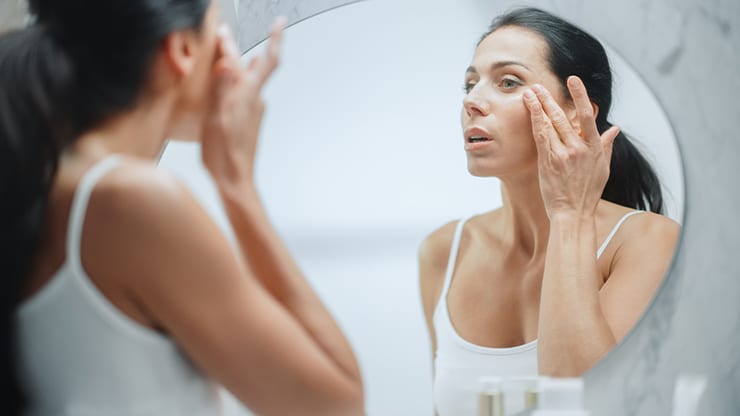The Case Against Sunscreen in Makeup: Understanding the Limitations and Risks

In recent years, there has been a growing trend of incorporating sunscreen into makeup products, offering the promise of sun protection while enhancing our appearance. However, it’s important to critically evaluate the effectiveness and safety of sunscreen in makeup. This article aims to shed light on the reasons why I do not recommend relying solely on sunscreen in makeup for sun protection.
Limited Protection and Reapplication Challenges:
One of the key issues with relying on sunscreen in makeup is the limited duration of protection it offers. Most sunscreens, including those found in makeup products, provide protection for approximately two hours after application. This means that if we apply sunscreen-containing makeup in the morning, we are likely to have minimal protection by the time the afternoon arrives, especially during the peak hours of sun intensity.
Reapplication of sunscreen is crucial to maintain adequate protection. The American Academy of Dermatology recommends reapplying sunscreen every two hours, especially when exposed to direct sunlight. However, in the case of makeup, reapplication can be challenging. Applying additional layers of makeup on top of existing makeup can lead to an unnatural appearance and may not provide the desired coverage. As a result, many individuals fail to reapply sunscreen throughout the day, leading to reduced protection against harmful UV rays.
Chemical Sunscreens and Potential Risks:
Another important consideration is the type of sunscreen typically found in makeup, which is often chemical sunscreen. Chemical sunscreens work by absorbing UV radiation and converting it into heat. While they have been approved for use and are generally considered safe, it is worth noting that using makeup with chemical sunscreen exposes the skin to a variety of chemicals on a daily basis.
The potential risks associated with these chemicals are still a subject of ongoing research. Some individuals may experience skin irritation, allergic reactions, or sensitivity to certain sunscreen ingredients. Furthermore, concerns have been raised regarding the potential absorption of these chemicals into the bloodstream. While studies on the systemic effects of sunscreen chemicals are inconclusive and more research is needed, it is understandable that some individuals may prefer to minimize their exposure to these substances.
Think about this. It means that the makeup industry is ordering more chemicals from big chemical companies, which will result in the manufacture of more chemicals and this means that there’s going to be more chemicals dumped into our environment – both, from the manufacturing process and also from the use of these makeups. When we wash our face and that goes down the drain we are dumping more chemicals into the water system. This is all for nothing. These products do not protect us against the UV rays throughout the day. If you apply your makeup at 7:00 AM you’re “protection” is going to last until 9:00 AM. This is a ridiculous practice and we have to move away from it.
Consider, that if you are using makeup that includes sunscreen, that you are simply absorbing these toxins into your skin and body. These products DO NOT protect you from the UV rays across the day.
Hormone Disruptors
Chemical sunscreens, commonly found in makeup products, utilize ingredients such as oxybenzone, avobenzone, and octinoxate to absorb and dissipate UV radiation. While these chemicals have been approved for use in sunscreens, there have been concerns raised about their potential impact on human health and the environment.
One major concern is the potential for these chemical sunscreen ingredients to disrupt hormone function. Studies have shown that certain sunscreen chemicals, such as oxybenzone, may exhibit hormone-like activity in the body, potentially interfering with normal hormone signaling. Although the extent and clinical significance of these effects in humans are still being investigated, it is prudent to exercise caution, particularly for individuals with hormonal imbalances or those who are pregnant or breastfeeding.
Another concern revolves around the environmental impact of chemical sunscreens. When we swim in oceans, lakes, or other bodies of water, the sunscreen chemicals on our skin can wash off and enter the aquatic ecosystems. Research has shown that oxybenzone, in particular, can be harmful to coral reefs, leading to coral bleaching and reduced reef health. In response to these concerns, some areas have even implemented bans on sunscreens containing certain chemical ingredients to protect fragile marine ecosystems.
As the scientific community continues to study the potential risks associated with specific sunscreen chemicals, it is important to be informed and make choices that align with personal health priorities. For those seeking alternatives, mineral sunscreens containing ingredients like zinc oxide offer a different approach to sun protection. These mineral-based sunscreens work by physically blocking and scattering UV rays rather than being absorbed into the skin, making them a suitable option for individuals with sensitive skin or those looking to minimize their exposure to chemical ingredients.
Alternative Strategies for Sun Protection:
Given the limitations and concerns surrounding sunscreen in makeup, it is crucial to explore alternative strategies for sun protection, especially during peak sun hours. Here are a few recommendations:
1. Standalone Sunscreen: Instead of relying solely on sunscreen in makeup, consider using a separate, dedicated sunscreen product that offers broad-spectrum protection. This allows for easier reapplication and ensures consistent coverage.
2. Protective Clothing: Wearing sun-protective clothing, such as wide-brimmed hats, long-sleeved shirts, and sunglasses, can provide additional physical protection against harmful UV radiation.
3. Seek Shade: When the sun is at its peak intensity, it is advisable to seek shade and limit direct exposure. This can help reduce the risk of sunburn and skin damage.
4. Time Management: Plan outdoor activities earlier in the morning or later in the afternoon when the sun’s intensity is lower.
While the idea of having sun protection in makeup may seem appealing, it is important to recognize the limitations and potential risks associated with relying solely on sunscreen in makeup for adequate sun protection. Considering the need for reapplication, the use of chemical sunscreens, and the challenges of protecting the skin during peak sun hours, alternative strategies such as standalone sunscreens, protective clothing, seeking shade, and time management should be incorporated into our sun protection routines. By adopting a comprehensive approach to sun safety, we can better protect our skin from the harmful effects of UV radiation.
- Wang, S. Q., et al. (2019). Photoprotection: A Review of the Current and Future Technologies. Dermatology and Therapy, 9(1), 5-25.
- Schmitt, J. V., & Schmitt, R. M. (2019). Acne and Rosacea: Epidemiology, Diagnosis and Treatment. In G. E. Pierard & J. L. Pierard-Franchimont (Eds.), Acneiform Eruptions in Dermatology: A Differential Diagnosis (pp. 95-110). Springer.
- Krause, M., & Klit, A. (2015). Efficacy and Safety of Medical Sunscreens. European Journal of Dermatology, 25(S1), 23-27.
- Nakamura, N., et al. (2018). Hormone-like Activities of Environmental Chemicals in the Estrogen Receptor Assay Systems. Journal of Health Science, 64(4), 247-255.
- Downs, C. A., et al. (2016). Toxicopathological Effects of the Sunscreen UV Filter, Oxybenzone (Benzophenone-3), on Coral Planulae and Cultured Primary Cells and Its Environmental Contamination in Hawaii and the U.S. Virgin Islands. Archives of Environmental Contamination and Toxicology, 70(2), 265-288.
Enjoying this content? Sign up for updates... It's FREE!

















